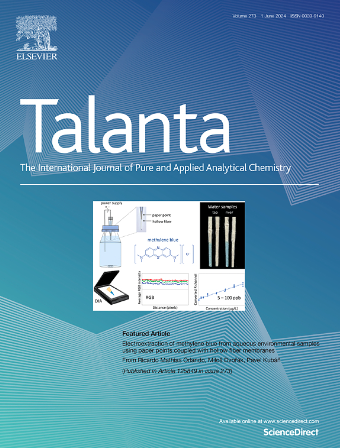利用cnn驱动的一维光谱二维分类在sers集成微流体中进行细菌鉴定
IF 5.6
1区 化学
Q1 CHEMISTRY, ANALYTICAL
引用次数: 0
摘要
细菌传感涉及复杂多变的样品,需要先进的处理和分析方法。为了应对这些挑战,机器学习——尤其是深度学习——和基于sers的微流体已经显示出巨大的前景。虽然以前的研究主要集中在一维光谱分类上,但尚未探索SERS光谱的二维表示的使用,特别是用于芯片上的细菌鉴定。在这项工作中,我们引入了一种新的框架,将支持sers的微流体与优化的2D卷积神经网络(2D- cnn)相结合,用于细菌分类。通过直接激光写入实现了微流控芯片内部SERS集成,实现了自定义有源区域和高效的片上测量。我们系统地评估了9种不同的一维到二维光谱变换,在受控数据集上,光谱图和连续小波变换的测试精度分别为99%和97%。通过迁移学习,我们在片上数据集上实现了100%的准确率,证明了模型对新数据的适应性。相比之下,其他转换,如成对距离和自相关,执行率低于93%,表明它们捕捉细微光谱特征的能力有限。该框架提供了高样本控制、并行化和扩展细菌数据库的潜力,使其成为罕见感染等低数据量情况的理想选择。在菌株、环境和实际挑战方面的进一步开发和测试可以进一步提高我们的方法在现实世界诊断中的可靠性。本文章由计算机程序翻译,如有差异,请以英文原文为准。
Bacterial identification in SERS-integrated microfluidics using CNN-driven 2D classification of 1D spectra
Bacterial sensing involves complex and variable samples that require advanced handling and analytical methods. To address these challenges, machine learning—especially deep learning—and SERS-based microfluidics have shown great promise. While previous studies have majorly focused on 1D spectral classification, the use of 2D representations of SERS spectra has not yet been explored, particularly for on-chip bacterial identification. In this work, we introduce a novel framework that combines SERS-enabled microfluidics with optimized 2D convolutional neural networks (2D-CNNs) for bacterial classification. SERS integration inside microfluidic chips was achieved through direct laser writing, enabling custom active areas and efficient on-chip measurements. We systematically evaluated nine distinct 1D-to-2D spectral transformations, with spectrogram and continuous wavelet transform yielding test accuracies of 99 % and 97 %, respectively, on controlled datasets. Using transfer learning, we achieved 100 % accuracy on the on-chip dataset, demonstrating the model's adaptability to new data. In contrast, other transformations, like pairwise distance and autocorrelation, performed below 93 %, indicating their limited ability to capture subtle spectral features. This framework offers high sample control, parallelization, and the potential for expanding the bacteria database, making it ideal for low-data-volume situations such as rare infections. Further development and testing across strains, environments, and practical challenges can further improve our approach's reliability for real-world diagnostics.
求助全文
通过发布文献求助,成功后即可免费获取论文全文。
去求助
来源期刊

Talanta
化学-分析化学
CiteScore
12.30
自引率
4.90%
发文量
861
审稿时长
29 days
期刊介绍:
Talanta provides a forum for the publication of original research papers, short communications, and critical reviews in all branches of pure and applied analytical chemistry. Papers are evaluated based on established guidelines, including the fundamental nature of the study, scientific novelty, substantial improvement or advantage over existing technology or methods, and demonstrated analytical applicability. Original research papers on fundamental studies, and on novel sensor and instrumentation developments, are encouraged. Novel or improved applications in areas such as clinical and biological chemistry, environmental analysis, geochemistry, materials science and engineering, and analytical platforms for omics development are welcome.
Analytical performance of methods should be determined, including interference and matrix effects, and methods should be validated by comparison with a standard method, or analysis of a certified reference material. Simple spiking recoveries may not be sufficient. The developed method should especially comprise information on selectivity, sensitivity, detection limits, accuracy, and reliability. However, applying official validation or robustness studies to a routine method or technique does not necessarily constitute novelty. Proper statistical treatment of the data should be provided. Relevant literature should be cited, including related publications by the authors, and authors should discuss how their proposed methodology compares with previously reported methods.
 求助内容:
求助内容: 应助结果提醒方式:
应助结果提醒方式:


